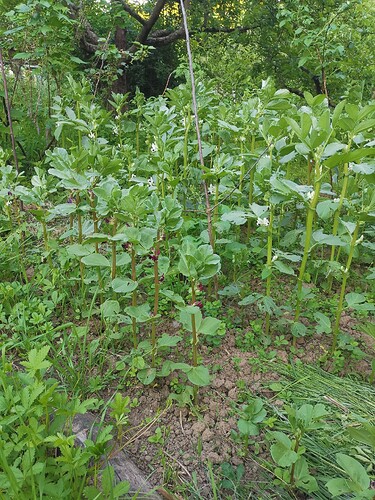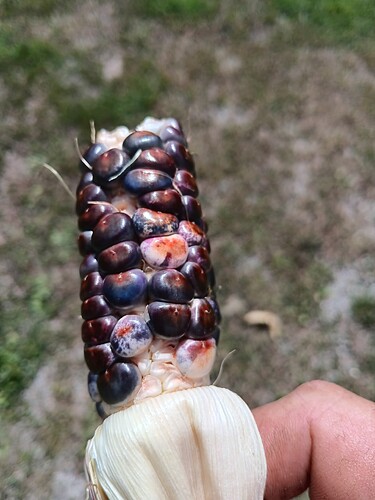J Larsen
ya i feel the same way, to me it’s about taste and quantity. To me adding color is more about adding variety that makes it stronger than looks
Randy S
This last summer was my first year of Landrace gardening so breeding plants that will survive and produce edible food in my garden is my first priority right now. That said I have ideas about what I want in the future like including some Puerto Rico Everblush okra in my crop next year for the purple blush, or adding Guatemalan Ayote squash to my squash Landrace for the green flesh. What made me read Joseph’s posts elsewhere was the pictures he posted of his crops. So to answer your question I thinks appearance is important.
Emily S
One of the advantages of pretty edibles, for me, is that my husband is willing to have those in the front yard. He wants our front yard to be pretty. I want to grow as much food as possible. Therefore, finding plants that fulfill both roles is ideal for both of us!
Julia D
I love that strong colors are also an indication of more phytonutrients and anti-oxidents. It’s probably why humans are so attracted to pretty colors. So yes I am breeding for lots of colors! But in general I tend to be more focused on things like functionality/plant health/flavor/disease resistance/nutrient density, and luckily those will probably also tend to be more beautiful. Red fleshed apples are an example of that, colored corn, and the potatoes I’m selecting for.
Emily S
Good point! Really showy flowers also have the benefit of being more attractive to pollinators. That can help a lot with the health of the population over the long-term.
That may be why we instinctively find them attractive, too.
Jesse I
I like variety, but I’m not focused in beauty. What works is more important. It’s good to note what beauty means. In your example glass gem corn it means genetic diversity (as far as i know about corn genetics), but in purple fava it might mean lack of genetic diversity depending on how hard bottle neck it has gone trough during development. Some traits might be extremely hard to stabilize and you might end up with plant equivalent of a bulldog. Some might not be as hard to stabilize, but still stable variety would be geneticly less diverse. So plants that need to stabilized from seed beauty might not be good in it self, but it might be good to have it in a mix where it will pop up randomly. Something like potatoes or sweet potatoes were plants are grown from tubers or cuttings (or forementioned corn), were beauty itself generally doesn’t have possible disadvantages, definetely can go more beauty first.
Emily S
That makes sense! I also think that a population of multicolored beans is way prettier than a population of single-colored beans, anyway. So if purple is hard to stabilize, for instance, just saving and planting those purple seeds preferentially will help it to keep popping up, even if you have all colors of the rainbow in there.
Jesse I
Or you could cross purple with as many other varieties and make landrace that way by selecting for purple colour for couple generations. It wouldn’t be all purple, but probably enough to have some colour. Not sure how that trait behaves in beans. Only have some experience with purple chilies. If it’s simply mendelian trait then it should be quite easy to favour it and have a population where it’s common.
Mark R
Beauty has never been and still isn’t a primary goal in my crop breeding projects but as
@Julia D
mentioned it sometimes, maybe often just happens to go along with other good things.
Take watermelons for example. I’ve grown them for fifty years or more and until about ten years ago had no clue that they come in colors other than pale red. Well, they do, there are intense pink ones, deep red ones, brilliant yellow, orange and rarely snowy white. All I did was select for small size and great flavor; the pretty color was just an unexpected bonus.
My “broccoli-ish” that I’m selecting primarily for winter hardiness, production and great flavor by chance as lots of pretty colors. Plants with bluish leaves lined with red or purple veins are delicious and pretty.
Sweet potato vines come in all kinds of shades, light green, dark green, purple to almost black. The roots vary from near white to solid dark purple. Yellow is my favorite, flavor wise but also rather rare, especially in a plant that also sets seeds well.
A new project of mine is to breed a beautiful popcorn. Unlike Glass Gem it won’t be just pretty but delicious as well. I don’t like multi-color on the same ear but rather each individual ear to be a single color. Different colors have different flavors as Carol Deppe describes in one of her books. To accomplish that color in the aleurone layer, which Glass Gem apparently has in spades has to be eliminated.
Below is a photo of some of the ears from the G1 generation of my new popcorn. The large yellow ears are modern F1 hybrids of popcorn. The smaller ones are mostly miniature ornamental popcorns. The mini ornamentals were detasseled and pollinated with the modern commercial F1s. I’ve obtained two more locally grown production hybrids (Indiana is a big popcorn producer) which will serve as the fathers next year for seed from the mini ears. For the next two or three years I’ll just continue this until there is nothing left of the mini ornamentals except the color. The two new F1s I’m adding next year have white endosperm and colorless pericarp.
The end result will not be like Glass Gem in that all the aleurone color will be selected out leaving individual ears ranging from dark red to white or yellow and lots of colors in between, including chin mark. It will also have a shorter maturity time and will actually be a delicious popcorn, rather than just a decoration. I expect colors will range similarly to Carol’s Magic Manna except in popcorn rather than flour corn. I’m also pursuing the same goal in my flint corn project.
It also won’t be like the original ornamentals in that the ears and kernels will be much larger and again it will be good popcorn instead of just decoration.
Reeds “More Than Ornamental” Popcorn
Skot C
Interesting how beauty seems to arise on it’s own, and I appreciate that it’s an afterthought to the importance of productivity and flavor.
I’ve felt the same with my Glass Gem. After breeding it for beauty for a few years I tried to use it as a popcorn and it was terrible! It had a poor pop rate and the kernels that did pop were small and dense, difficult to eat. I thought that maybe this was due to having either too high, or too low, of a humidity level (commercial recommendation is around 14-15%) but after a number of trials I realized that it was probably the genetics.
So the next stage is going back and breeding for better popcorn. Oi.
If I had focused on this FIRST I would have probably still had the beauty, but also productivity.
So that’s a thought for the future. Let beauty come as a natural event, rather than an intentional selection, especially if productivity is important.
Emily S
I agree. I’m starting to think that a lot of things we humans find beautiful are things that generally represent greater health, either of an individual or a species. Sometimes our specific aesthetic preferences wander afield, but I think the universal standards of beauty are usually signs of natural systems working properly.
Wojciech G
I have a strong permaculture background, moreover, in a very classic form (think Permaculture Designers’ Manual by Bill Mollison) so for me it’s been always all about function, not form. As my masters were saying, beauty comes on its own, because nature is beautiful.
However, I’m addicted to beautiful shapes and colours of tomatoes. I know, I’m guilty of heirloom craze. Same for hot peppers. Thanks to this commonity and this year’s landrace project, I have fallen in love with corn. Yet still, my priority is function, so I wouldn’t mind the ugliest tomato in the world if only it was tasty and late blight resistant (still looking for one).
Gregg M
to get back to Skot’s original question re fava flower colour, I’ve decided to broadly select for a coloured flower landrace - this year i got a lovely lavender, and would like to add chocolate flowered - i forgot to tag it. the research literature mentions pure white flowers, and yellow flowers - but I’ve never see n them.
Reason - lots of commercial growers here use faba flowers as a harvest for restaurant garnish sales - i would love to give them some variety. And imagine a multicoloured faba landrace in full bloom! Beauty AND utility. (One issue with coloured fava dried beans highlighted in the research literature is the presence of tannins, which may produce some digestibility issues.)


















